Seven things for investors to keep in mind in rough times like these
Successful investing can be really hard in times like the present. Falls in share markets and other assets are stressful as no one likes to see their wealth decline, and the natural inclination is to retreat to safety.
From the highs of last year/early this year to recent lows, global shares have fallen about 25%. Australian shares have held up better, remaining up from their June low, at which point they had had a fall of 16% from their high in August last year, but they remain vulnerable to the lead from global shares.
While shares have managed to find technical support in recent days and could bounce further given high levels of negative sentiment, the near-term downside risks for shares remain high. This reflects the same array of macro risks that have been weighing on them all year, notably:
- High inflation and ultra-hawkish global central banks;
- The US dollar trending up on safe-haven demand and Fed rate hikes risking a financial accident – with mayhem in the UK adding to fears of a crisis
- An escalation in the Ukraine war, along with other geopolitical risks;
- High and still rising recession risks; and
- Downwards revisions to earnings expectations flowing from all this.
We had a detailed look at the issues a few weeks ago along with signs of light at the end of the tunnel (see here), but I will be the first to admit my crystal ball gets even hazier at times like the present. As always, the turmoil in markets is being met with lots of prognostication. Some of these are enlightening, but much of it is noise.
But to borrow one of my favourite quotes from Mark Twain: “history doesn’t repeat but it rhymes”.
While the weakness we are going through differs in detail from
rough patches in the past, basic investment principles still apply. It’s hard
to say anything new other than to reiterate them. This is why I think it's time to revisit this piece.
#1 Share market falls are normal – the key is to make the most of the power of compound interest
While they all have different triggers and unfold differently, periodic share market falls are healthy and normal.
Sometimes they are just 5% to 20% corrections, but every so often they can be deep bear markets with
falls up to around 50% as in the GFC. But while share market pullbacks can
be painful, it’s the way the share market has always been, so they are
nothing new.
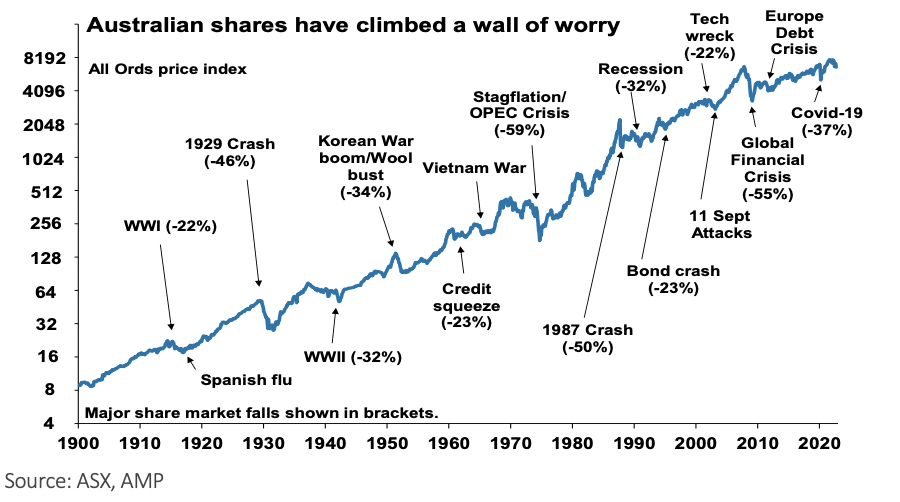
Bouts of volatility are the price we pay for the higher longer-term returns from shares compared to other assets like cash and bonds.
The next chart shows the value of $1 invested in various Australian assets in 1900 allowing for the reinvestment of dividends and interest along the way. That $1 would have grown to $243 if invested in cash, to $881 if invested in bonds, and to $691,806 if invested in shares.
While the average return since 1900
is only double that in shares relative to bonds, the huge difference
between the two at the end owes to the impact of compounding returns
on top of returns. So, if we want to grow our wealth, we need exposure
to growth assets like shares to make the most of the power of compound
interest, but with that comes rough patches every so often.

#2 The key is not to get thrown off by cycles - selling shares after a fall turns a paper loss into a real loss
When shares are falling sharply, it's naturally tempting to sell. At least it may
then be easier to sleep at night. But selling shares or switching to a more
conservative investment strategy whenever shares suffer a cyclical setback
just turns a paper loss into a real loss with no hope of recovering.
#3 Timing is hard
You may be thinking “but I will reinvest once uncertainty is removed”. But the risk is you don’t feel confident to get back in until long after the market has fully recovered, which may be well above the level you sold out at. Trying to time the market is very difficult.
A good way to
demonstrate this is with a comparison of returns if an investor is fully
invested in shares versus missing out on the best (or worst) days. The
next chart shows that if you were fully invested in Australian shares
from January 1995, you would have returned 9.2% per annum (including
dividends but not allowing for franking credits, tax, and fees).
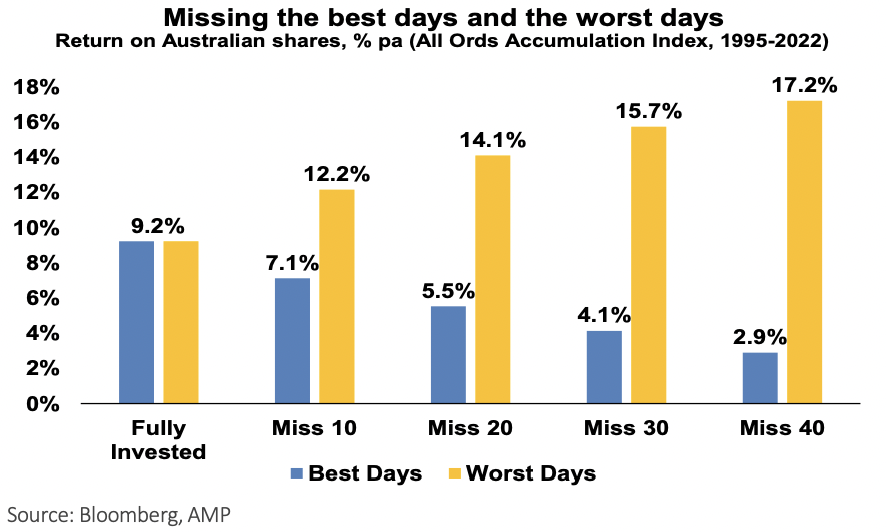
If by trying to time the market you avoided the 10 worst days (yellow bars), you would have boosted your return to 12.2% pa.
If you avoided the 40 worst days, it would have been boosted to 17.2% pa.
Fantastic! But this is very hard to do, and many investors only get out after the bad returns have occurred, just in time to miss some of the best days.
For example, if by trying to time the market you miss the 10 best days (blue bars), the return falls to 7.1% per annum. If you miss the 40 best days, it drops to just 2.9% per annum. Hence the old cliché that “it’s time in the market that matters, not timing”.
The following chart shows the difficulties of short-term timing in another way. It shows the cumulative return of two portfolios.
- A fixed balanced mix of 70% Australian equities, 25% bonds, and 5% cash.
- A “switching portfolio” starts off with the above but moves 100% into cash after any negative calendar year in the balanced portfolio and doesn't move back until after the balanced portfolio has a calendar year of positive returns. We assumed a two-month lag.
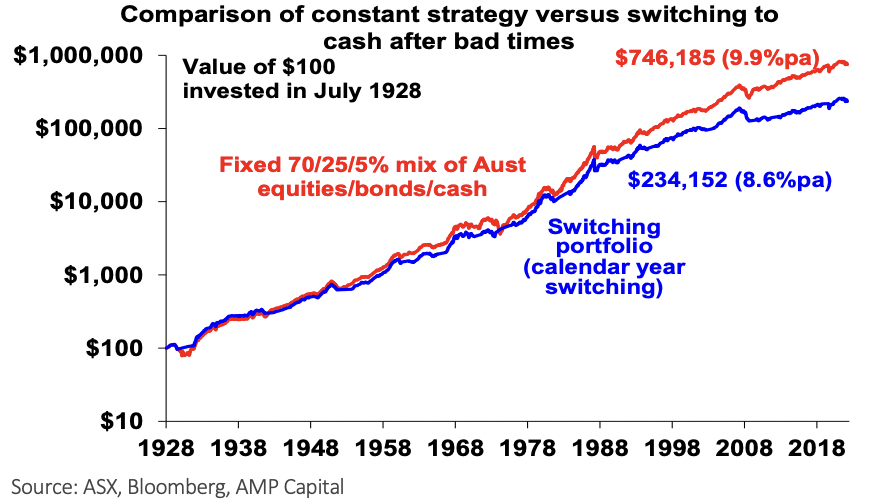
Over the long run, the switching portfolio produces an average return of 8.6% pa versus 9.9%pa for the balanced mix. From a $100 investment in 1928, the switching portfolio would have grown to $234,152 by September, but the constant mix would have increased to $746,185.
The best way to guard against selling on the basis of emotion after
weakness is to adopt a well thought out, long-term strategy and stick to it.
#4 Share market pullbacks provide opportunities
When shares and all assets fall in price, they’re cheaper and offer higher long-term return prospects. As a result of the fall in share and bond prices (and the resultant decline in PEs and rise in dividends yields and bond yields), our estimated medium-term return projections for a diversified growth mix of assets have improved from around 4.9% per annum to around 6.7% per annum.
The key is to look for opportunities pullbacks provide. It’s impossible to
time the bottom, but one way to do it is to “average in” over time.
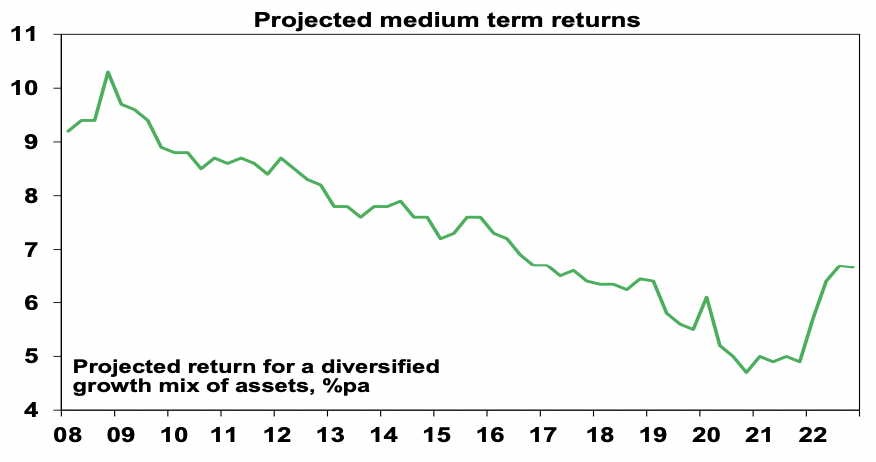
#5 Australian shares offer an attractive dividend yield
This is particularly so compared to bank deposits. Companies don’t like to
cut their dividends, so the income flow you are receiving from a well diversified portfolio of shares is likely to remain attractive, particularly
against bank deposits even though deposit rates are slowly rising.
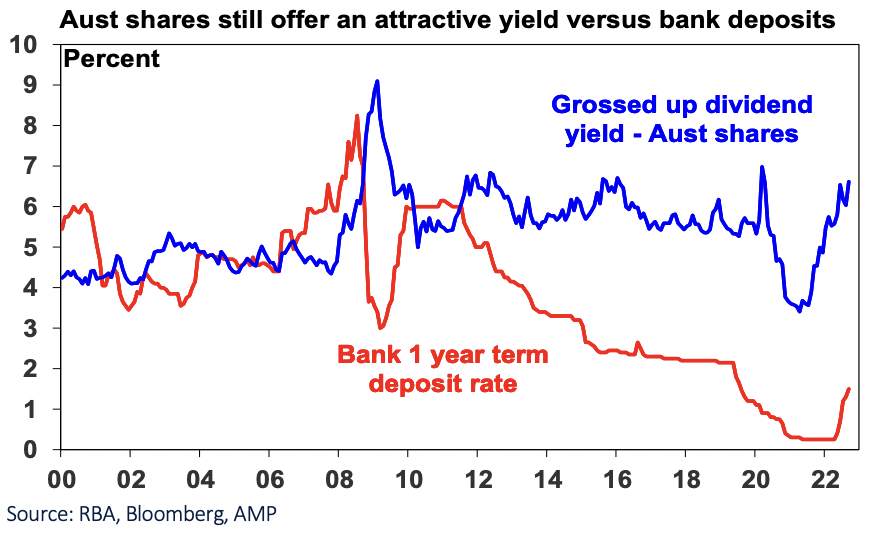
#6 Shares invariably bottom with maximum bearishness
Shares and other related assets often bottom at the point of maximum bearishness, i.e. just when you and everyone else feel most negative towards them. This is when investors have lots of cash on the sidelines, which provides fuel for an eventual rebound. This is the point of maximum opportunity.
This is obvious in a way because shares could hardly bottom when everyone is already bullish because there would be no one to buy. The problem is that it’s hard for most people to commit to buying shares when there is so much gloom around. And, of course, investor sentiment could still get more negative in the short term before it bottoms.
#7 Turn down the noise
At times like this, negative news reaches a fever pitch. Talk of billions wiped off share markets and warnings of disaster help sell copy and generate clicks & views. But we are rarely told of the billions that the market rebounds and the rising long-term trend in share prices add to the share market. Moreover, they provide no perspective and only add to the sense of panic.
All of this makes it harder to stick to an appropriate long-term strategy let alone see the opportunities that are thrown up. It's best to turn down the noise of all the negative news flow (and watch Elvis films).
Never miss an insight
If you're not an existing Livewire subscriber you can sign up to get free access to investment ideas and strategies from Australia's leading investors.
And you can follow my profile to stay up to date with other wires as they're published – don't forget to give them a “like”.
1 topic

